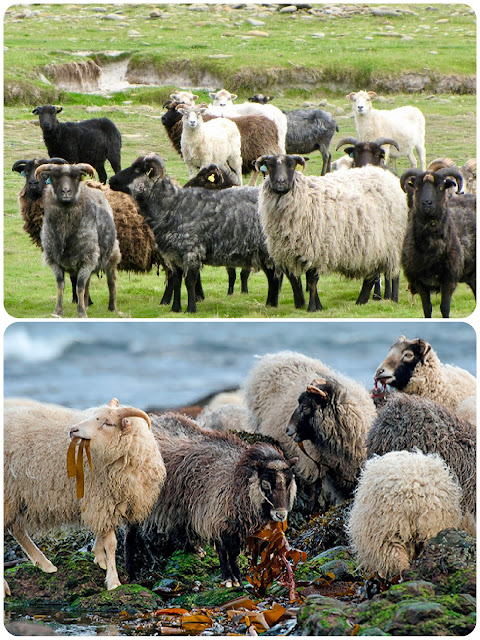The North Ronaldsay Sheep is a very small, fine boned yet hardy and prolific sheep that has adapted to the terrain of the Orkney Islands that are situated some 10 miles north of the North Coast of mainland Scotland with North Ronaldsay being one of the largest and the most northern of the 70 islands that make up the Orkney Islands. North Ronaldsay, at its highest point, rises just 54m above the North Sea.

In the early 1800's the residents would either burn or dry the abundant seaweed that covered the shores and sell their iodine-rich kelp and ash to England. This trade made up a good amount of their livelihoods. In 1832 the residents built a 6ft high, 13 mile long dry stone wall around the island and placed their sheep outside the wall to prevent them eating crops that they were growing on the uplands of the island. The sheep had always eaten large amounts of seaweed but they now had to survive almost exclusively on a seaweed diet. Nowadays there are around 60 people living on the island working in the lighthouse and communications, tourism and tending the sheep.
As I've already said they are a small, fine-boned yet hardy and prolific breed. The rams have horns and a fringe of coarse hair under the neck whereas the ewes are not always horned. According to the British Wool Marketing Board, was established in the UK during the 9th century and at the time of writing, the North Ronaldsay sheep are in the Rare Breeds Survival Trust category 3: Vulnerable (500-900) registered breeding ewes. They can still be found on the Island of North Ronaldsay but attempts to "improve" the breed by crossbreeding have failed because the resulting animals have not been able to survive on the island. In 1974 TV presenter Adam Henson, then aged 8, accompanied his father, Joe Henson, founder of the Rare Breeds Survival Trust, travelled to North Ronaldsay Island on an excursion to buy 287 sheep as the Trust had purchased another island, Linga Holm, as an alternative breeding site and 179 sheep were transported there with 108 sheep being bought back to found new flocks in Scotland and England. There are some that are also kept by rare breed enthusiasts elsewhere in the UK.
They produce a small size fleece that is anywhere from 0.9kg up to about 2.5kg with a staple length of 2-4 inches (5 to 10cm). They have a double-coated fleece with the undercoat being lovely and soft to keep them warm and the outercoat being made up of guard hairs that are coarse that protects them against wet weather. Most of the sheep have white or grey fleece (the grey is actually white fleece with coarse black guard hairs) but you can also get black and brown. The locks are triangular with wide bases and the crimp varies with the undercoat tending to have fine even crimp.
This fleece will need to be washed well before any attempt to prepare or spin, especially if your fleece comes from the island as the fleece will contain a lot of sand and sea salt and around 50% of the weight of the fleece will be because of that. It is a difficult fleece to card due to the matting of the locks and combing removes the guard hairs effectively to leave the nice soft wool behind for use. You need to decide if you want the texture of the guard hairs in your yarn, they also provide colour in a white fleece to make it look grey but they also add a scratchiness factor. Guard hairs will not take up the dye as they are generally black but the wool content will and so if you dye light coloured wool it will give an unusual effect if you are leaving in the black guard hairs.
Yarns spun from North Ronaldsay fleece that have the guard hairs left in are definitely suited to household items and upholstery and those that have had the guard hairs removed will be more Shetland like and suitable for fine textiles.
I have bought this breed in as 100g of prepared roving. There are black hairs throughout but they're not overly coarse.
My finished yarn is of reasonably soft quality to the touch of the hand but you can feel the prickly hair sticking out if you put it to your neck but its not overly nasty and I do like the colour. My knitted piece for the project only took 29g/67m so I have some left to do whatever with.


















